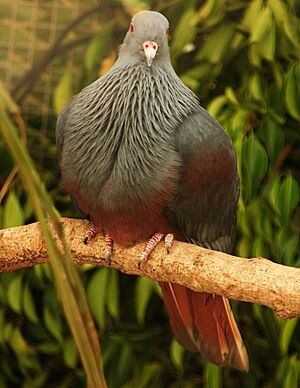New Caledonian imperial pigeon facts for kids
Quick facts for kids Goliath imperial pigeon |
|
|---|---|
 |
|
| Conservation status | |
| Scientific classification | |
| Genus: |
Ducula
|
| Species: |
goliath
|
The goliath imperial pigeon (Ducula goliath) is a very large bird. It is also known as the New Caledonian imperial pigeon or the notou. This amazing bird lives only in New Caledonia. It prefers to live in humid forests. Sadly, experts say it is a near-threatened species. This means its population might be at risk in the future.
Contents
What is a Goliath Imperial Pigeon?
This pigeon was first described in 1859 by George Robert Gray. Its scientific name is Ducula goliath. It is a "monotypic species." This means it is the only species in its group.
Appearance: What Does It Look Like?
The goliath imperial pigeon is one of the biggest tree-dwelling pigeons. It is about 51 cm (20 in) long. That's about the size of a large ruler! It is a slender bird with a long tail. It weighs between 600–716 g (21.2–25.3 oz).
Colors and Features
Its head and neck are a pretty blue-grey color. Its upper body and wings are a sooty-grey. The tail is black with a dark chestnut band. The feathers on its neck and upper chest look shaggy. This is because they are split at the ends.
The lower chest is sooty-grey. Its belly and sides are purplish-chestnut. The area near its tail is buffy-yellow. This pigeon has bright red eyes. Its beak and feet are pinkish or reddish. Young birds look a bit duller. They do not have the shaggy feathers yet.
Where Does It Live?
This pigeon lives only in New Caledonia. You can find it on the main island, Grande Terre. It also lives on the Isle of Pines. Its favorite home is humid primary forest. It can live in forests up to 1,500 m (4,900 ft) high.
Daily Life and Habits
Goliath imperial pigeons are often seen alone or in pairs. They eat fruits, leaves, and flowers. They will travel to different areas to find the best fruits.
Sounds and Calls
Early in the morning, these pigeons warm themselves on a branch. Their call is a low "oom" sound. At dusk, they make a "gkrarr" noise.
Reproduction and Life Cycle
These pigeons breed from June to December. They build a nest from twigs on a tree branch. The nest is about 30–40 cm (12–16 in) wide. The female lays one white egg. Both parents take turns sitting on the egg to keep it warm.
Conservation Status
About 10,000 goliath imperial pigeons are thought to be alive today. People hunt this bird for food. This hunting is done both legally and illegally.
Hunting Rules
Traditionally, people hunt them for special feasts. This happens from late February to early May. However, hunting is only allowed on weekends in April. There is also a limit on how many birds a hunter can catch each day.
Future Risks
The International Union for Conservation of Nature (IUCN) says the species is safe for now. But its numbers might go down in the future. This could happen if hunting laws change. It could also happen if the hunting season becomes longer. Because of these risks, the IUCN calls it a near-threatened species.


